Overview
This article delineates five essential steps for successfully outsourcing software development services:
- Defining project scope
- Selecting the right partner
- Establishing communication protocols
- Implementing quality assurance
- Planning for delivery
Each step is bolstered by clear strategies and best practices, underscoring the critical role of stakeholder engagement, technical expertise, and continuous feedback in enhancing collaboration and ensuring project success.
Introduction
Outsourcing software development stands as a strategic avenue for businesses intent on enhancing operational efficiency and harnessing specialized expertise. By leveraging external teams, organizations can significantly reduce costs, gain access to a diverse talent pool, and concentrate on their core missions. However, navigating the path to successful outsourcing is not without its challenges.
How can companies ensure they select the right partner and implement effective management practices? This article explores five essential steps that will guide businesses through the outsourcing process, ultimately leading to successful software development outcomes.
Understand Software Development Outsourcing
Outsource software development services represents a strategic decision for businesses looking to enhance their software development capabilities. By hiring external teams or companies to manage software tasks, organizations can leverage specialized skills, reduce costs, and concentrate on their core activities. The key benefits of this approach are compelling:
- Cost Efficiency: Outsourcing significantly lowers development costs by providing access to global talent pools, enabling businesses to maximize their budgets.
- Access to Expertise: Companies can tap into specialized skills that may not be available internally, ensuring high-quality outcomes.
- Scalability: This approach allows organizations to adjust their development efforts in accordance with project demands, providing flexibility in resource allocation.
Understanding these factors is essential for companies evaluating how to outsource software development services as a viable strategy for their development needs. By recognizing the advantages, businesses can make informed decisions that drive efficiency and innovation.
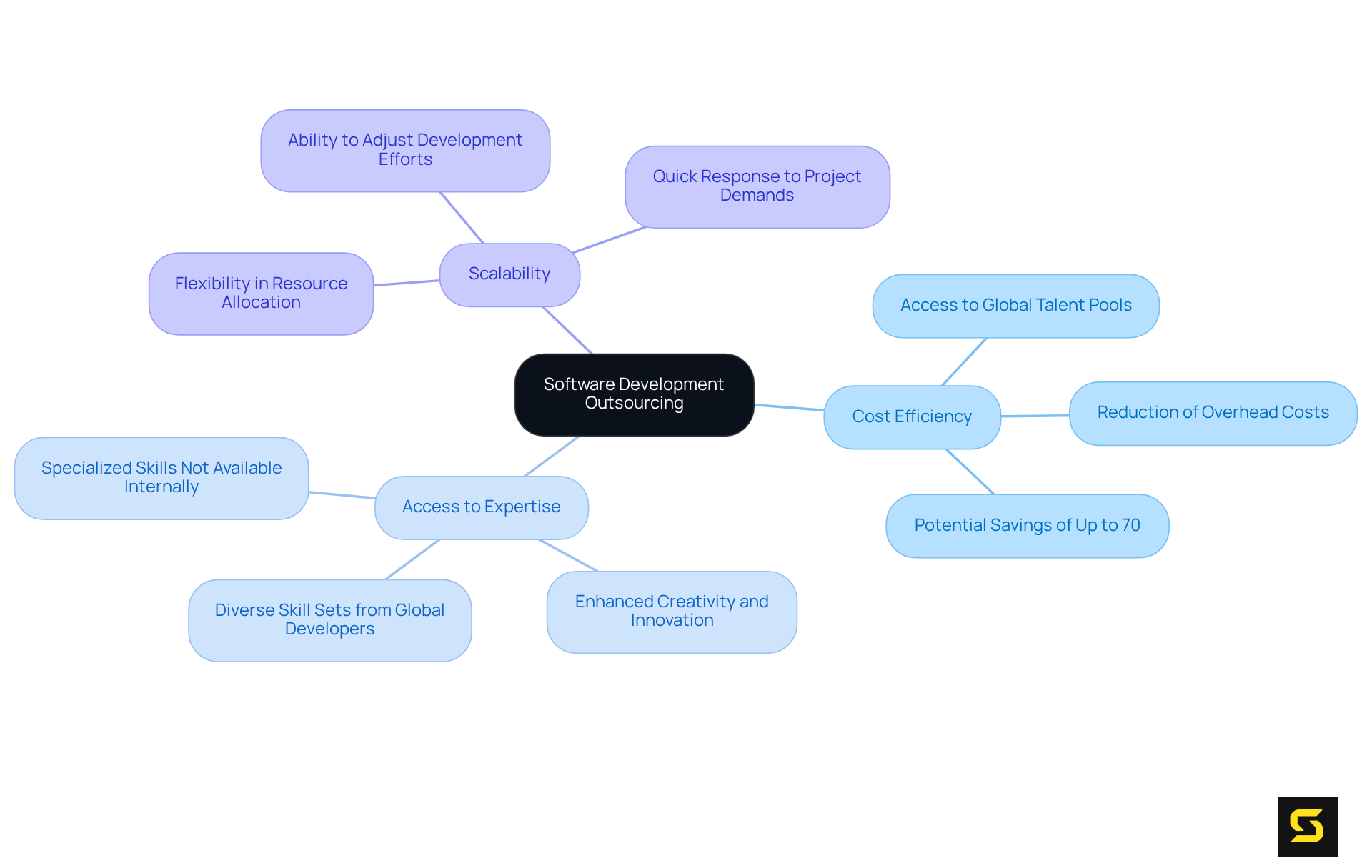
Define Project Scope and Requirements
To effectively define your project scope and requirements, it is imperative to follow these essential steps:
- Identify Objectives: Begin by clearly outlining the goals of your software endeavor. This includes identifying the specific problems it addresses and the value it delivers to users.
- Gather Requirements: Engage stakeholders actively through interviews, surveys, and workshops to collect comprehensive requirements. This approach guarantees that are taken into account, which is critical for success. Organizations that prioritize stakeholder involvement experience a notable improvement in success rates, with wasted investments due to poor performance averaging 4.8% for those that emphasize power skills.
- Document Deliverables: Create a detailed list of deliverables that encompasses features, functionalities, and performance metrics the software must achieve. Utilizing tools such as requirement traceability matrices and user stories can significantly aid in this documentation process.
- Establish Limits: Clearly define what is included and excluded from the scope of work to prevent misunderstandings and scope creep later on. Challenges like stakeholder conflicts and vague requirements can arise; thus, addressing these proactively is essential.
- Review and Validate: Share the scope document with stakeholders for feedback and validation. This step ensures alignment and consensus before proceeding with development. Ongoing validation of requirements with stakeholders is crucial to avoid overlooking their needs and ensuring success.
Effective stakeholder engagement throughout this process can greatly enhance outcomes. Organizations that prioritize this engagement see a marked improvement in success rates. As management specialists emphasize, clear and well-documented requirements are vital in preventing costly delays and ensuring that the final product meets user needs.
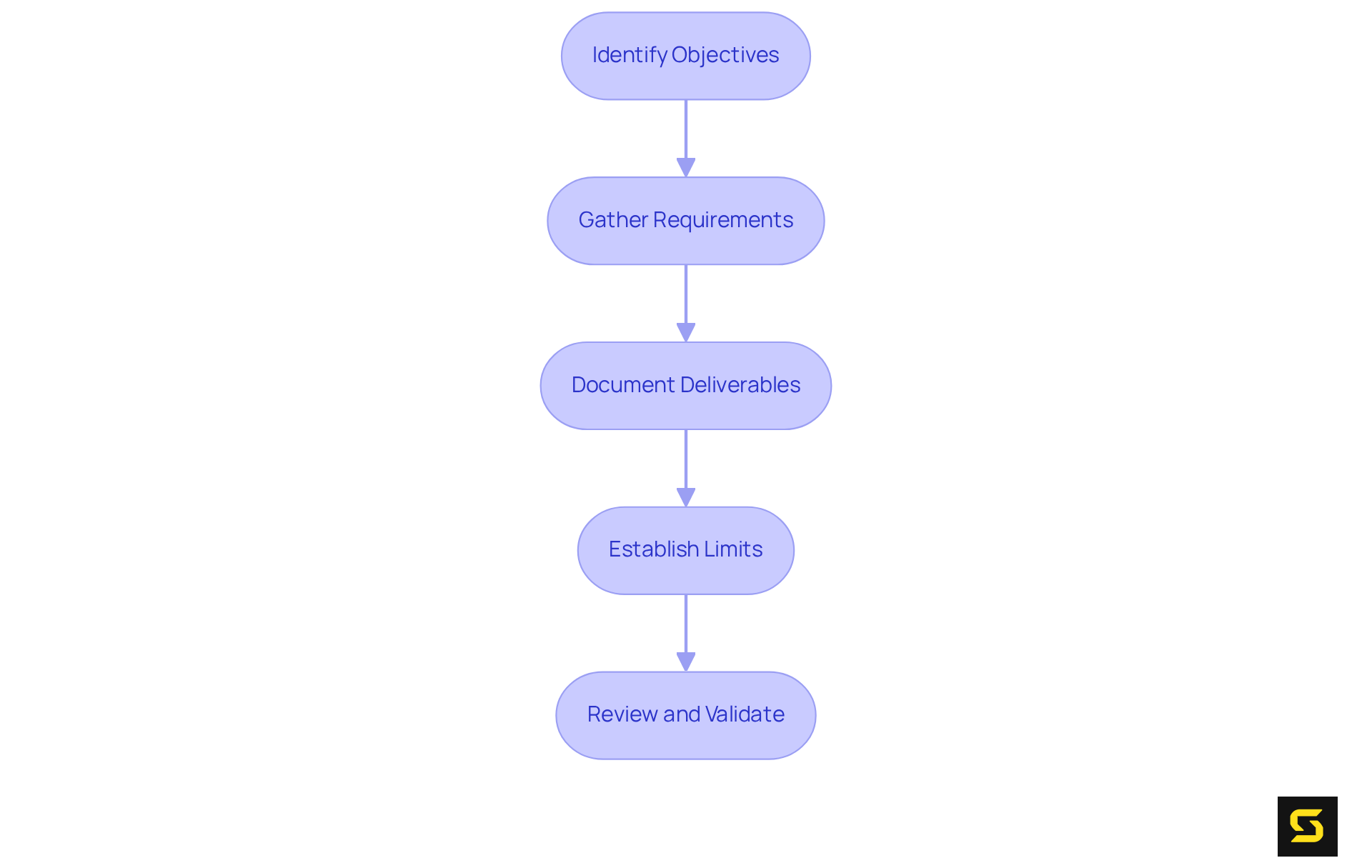
Choose the Right Outsourcing Partner
Selecting the appropriate outsourcing partner to outsource software development services is fundamental to the success of your application initiative. To guide your decision-making process, consider the following essential steps:
- Research Potential Partners: Identify companies with a proven track record in software development. Examine their portfolios and client testimonials to assess their reliability and quality of work. For example, firms like Goji Labs have effectively assisted over 500 companies in launching and scaling digital platforms, demonstrating their capability in the industry.
- Evaluate Technical Expertise: Ensure that the partner possesses experience with the technologies and methodologies relevant to your project. This includes familiarity with programming languages, frameworks, and management methodologies such as Agile. A partner's technical expertise can significantly influence outcomes, as evidenced by companies that have adeptly navigated complex challenges in their sectors.
- Assess Communication Skills: Effective communication is vital for successful collaboration. During initial discussions, evaluate how well potential partners articulate their ideas and respond to your inquiries. A partner that communicates clearly and promptly can mitigate misunderstandings and foster a productive working relationship. As Sandy K, Director at EitBiz, asserts, "Outsourcing programming isn't solely focused on reducing expenses; it's about making wiser decisions that accelerate growth."
- Consider Cultural Fit: A partner whose values and work culture align with your own can enhance collaboration and understanding. This cultural compatibility fosters smoother interactions and a more cohesive group dynamic, ultimately contributing to project success. Viewing this partnership as a long-term relationship rather than a one-off transaction is essential, as this perspective encourages commitment and mutual growth.
- Request Proposals: After narrowing down your options, solicit detailed proposals from shortlisted partners. These should outline their approach, timelines, and costs, enabling effective comparison. This step clarifies expectations and helps identify partners who are transparent and dedicated to delivering quality results. Exercise caution with partners offering the lowest bids, as this can lead to challenges such as poor communication and subpar code quality, ultimately resulting in higher costs over time.
- Utilize Evaluation Tools: Implement a to objectively assess potential partners based on criteria such as technical expertise, communication skills, and cultural fit. This structured approach streamlines your decision-making process.
By adhering to these steps, you can make an informed decision when selecting a partner to outsource software development services, laying the groundwork for a successful collaboration that drives innovation and growth.
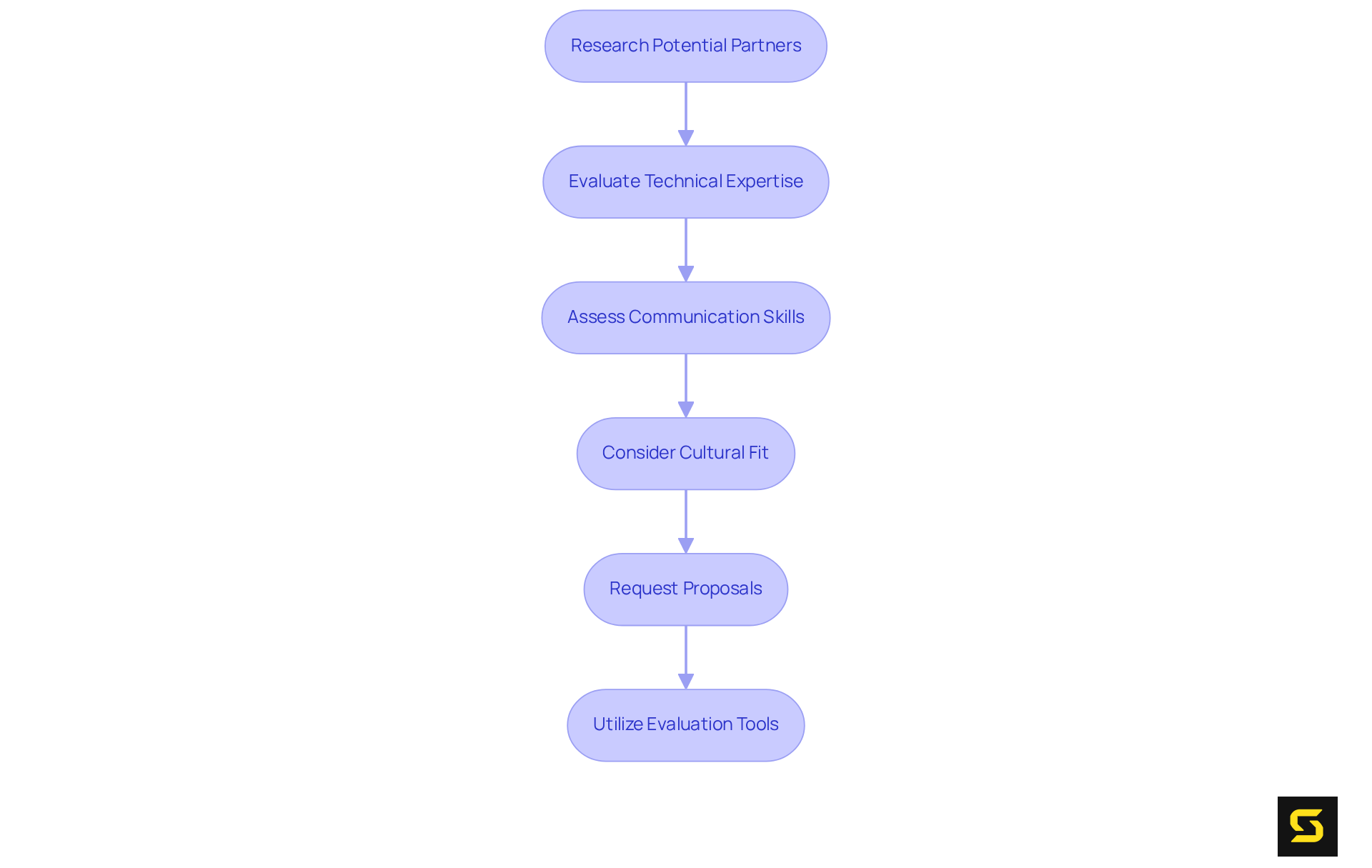
Establish Communication and Management Protocols
To establish effective communication and management protocols, consider the following strategies:
- Define Communication Channels: Select suitable tools for communication—such as Slack for instant messaging, email for detailed correspondence, and video conferencing platforms for face-to-face interactions. Ensure all group members are well-acquainted with these tools to facilitate seamless communication.
- Set Regular Check-Ins: Schedule consistent meetings to review progress, address challenges, and adjust plans as necessary. Frequent check-ins not only ensure the group is aligned but also promote accountability and transparency, significantly influencing the success of the initiative. Incorporating active listening during these meetings can lead to higher client satisfaction and reduce misunderstandings.
- Document Everything: Maintain comprehensive records of discussions, decisions, and any changes to the project scope. This practice guarantees clarity and serves as a reference point for all participants, minimizing misunderstandings and enhancing collaboration. Emphasizing the importance of thorough documentation can further improve group dynamics.
- Assign Roles and Responsibilities: Clearly delineate responsibilities within the project to prevent confusion and ensure accountability. When group members understand their specific roles, it streamlines workflows and boosts productivity.
- Encourage Feedback: Foster an environment where group members feel empowered to provide feedback and voice concerns. This openness enhances collaboration and leads to innovative solutions and a more unified group dynamic. Furthermore, consider introducing communication training to improve members' skills in giving and receiving feedback effectively.
By applying these protocols, teams can enhance their communication efficiency and management, ultimately resulting in successful outsource software development services. Utilizing like Asana, Trello, or Jira can also aid in tracking progress and maintaining accountability.
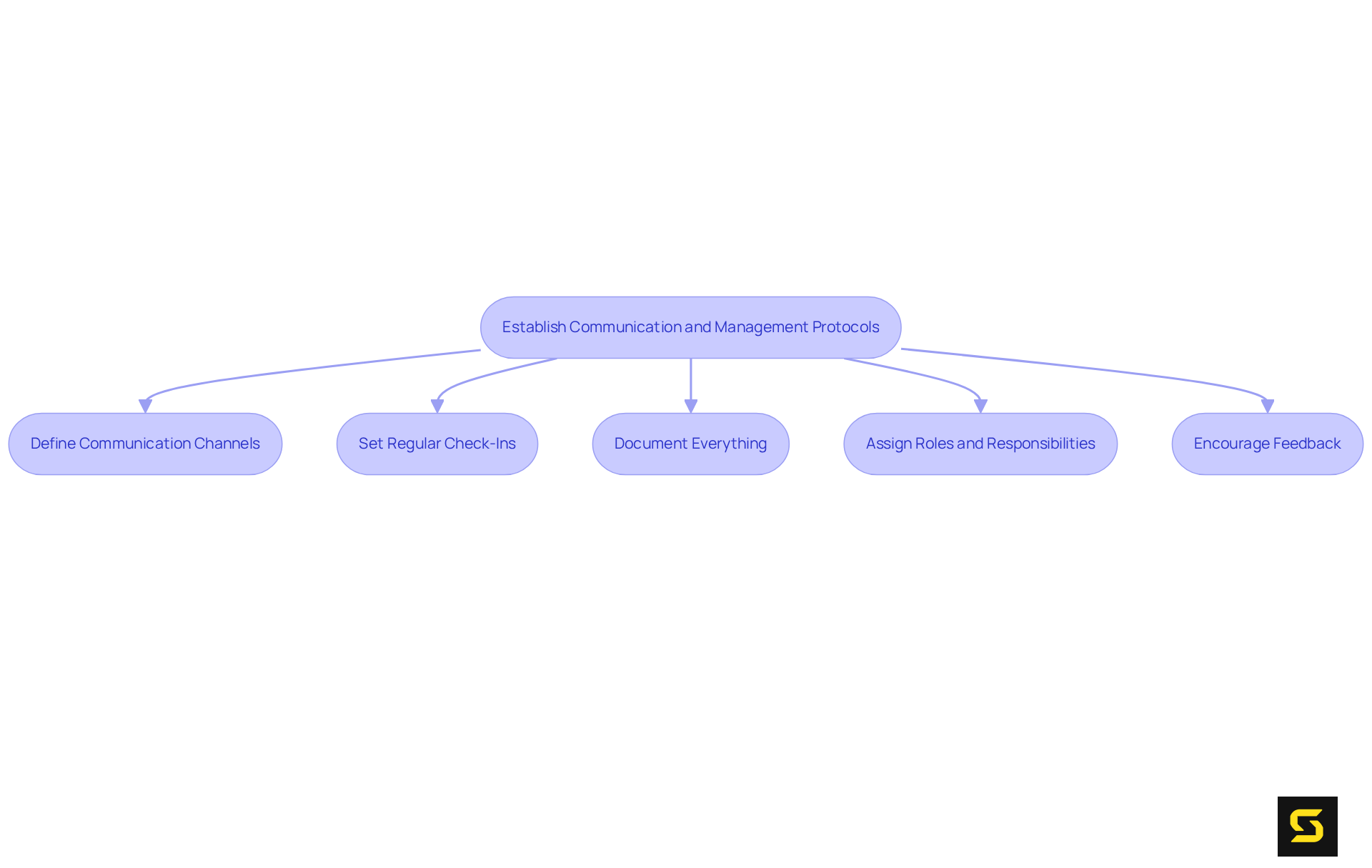
Implement Quality Assurance and Delivery Processes
To implement effective quality assurance and delivery processes, follow these essential steps:
- Define Quality Standards: Establish clear quality benchmarks that the software must meet, including performance, security, and usability criteria. This ensures that all stakeholders have a shared understanding of what constitutes success.
- Incorporate Testing Early: Integrate testing into the creation process from the outset. Research indicates that early feedback can significantly enhance efficiency and cost-effectiveness, preventing costly redesigns later. For instance, studies show that incorporating user feedback early can lead to a reduction in development costs by up to 30%. Utilize to streamline this process and ensure continuous quality checks.
- Conduct Regular Reviews: Schedule periodic reviews of the project to assess progress against quality standards. This practice allows teams to make necessary adjustments in real-time, fostering a culture of continuous improvement.
- Gather User Feedback: Actively involve end-users in testing phases to collect valuable feedback. Engaging users early helps identify real-world issues and ensures the product aligns with their needs, ultimately leading to improved user satisfaction and loyalty. As noted by industry experts, "By actively seeking out and addressing user feedback, developers can ensure that their software meets the needs and expectations of their target audience."
- Plan for Delivery: Develop a comprehensive delivery plan that outlines timelines, deployment strategies, and post-launch support. This preparation is crucial for ensuring a smooth transition to production and maintaining operational excellence. Emphasizing continuous quality assurance throughout the delivery process will help maintain high standards and adaptability.
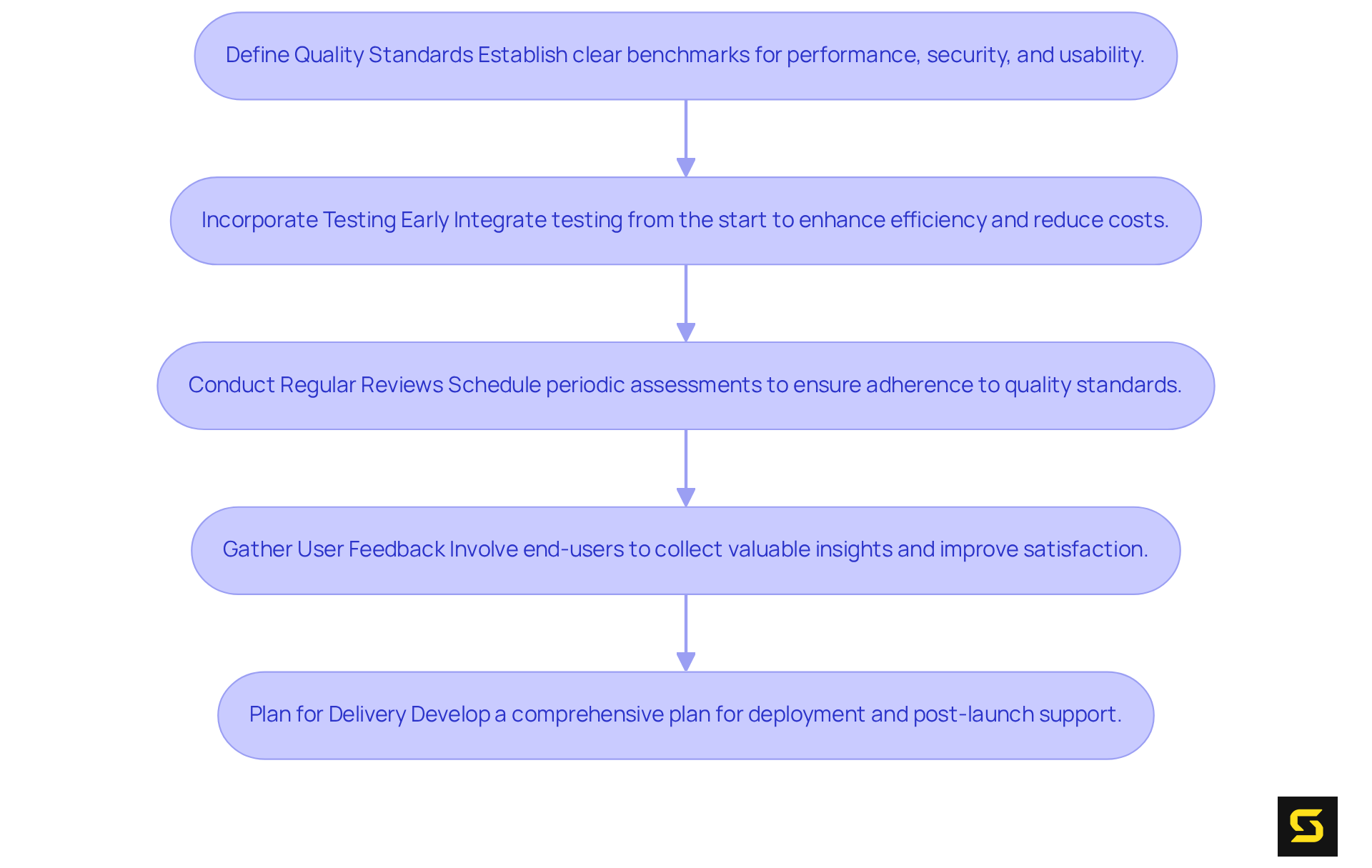
Conclusion
Outsourcing software development services stands as a strategic approach that can significantly elevate a business's operational efficiency and innovation potential. By leveraging external expertise, companies not only reduce costs but also gain access to specialized skills and scalable resources tailored to their project needs. This comprehensive guide outlines essential steps for successful outsourcing, emphasizing the importance of:
- A well-defined project scope
- Selecting the right partner
- Establishing robust communication protocols
- Implementing effective quality assurance processes
The key arguments presented throughout this article underscore the necessity of understanding the advantages of outsourcing, such as:
- Cost efficiency
- Access to global talent
Meticulously defining project requirements and actively engaging stakeholders can lead to better alignment and project success. Furthermore, choosing the right outsourcing partner based on technical expertise, communication skills, and cultural fit is crucial. Establishing clear communication channels and management protocols fosters collaboration, while rigorous quality assurance practices ensure that the final product meets the required standards and user expectations.
In a rapidly evolving technological landscape, embracing outsourcing for software development can be a game-changer for businesses striving to remain competitive. By adhering to the outlined steps and best practices, organizations can adeptly navigate the complexities of outsourcing. This not only paves the way for innovative solutions but also enables businesses to concentrate on their core competencies, ultimately driving growth and success in the marketplace.
Frequently Asked Questions
What is software development outsourcing?
Software development outsourcing involves hiring external teams or companies to manage software tasks, allowing businesses to leverage specialized skills, reduce costs, and focus on their core activities.
What are the main benefits of outsourcing software development?
The key benefits include cost efficiency, access to expertise, and scalability. Outsourcing lowers development costs, provides access to specialized skills, and allows organizations to adjust their development efforts according to project demands.
How can a company effectively define its project scope and requirements?
Companies can define their project scope and requirements by following these steps: identifying objectives, gathering requirements from stakeholders, documenting deliverables, establishing limits, and reviewing and validating the scope with stakeholders.
Why is stakeholder engagement important in defining project requirements?
Engaging stakeholders is crucial because it ensures that diverse viewpoints are considered, which significantly enhances the chances of project success and reduces wasted investments due to poor performance.
What tools can be used to document project deliverables?
Tools such as requirement traceability matrices and user stories can be utilized to create a detailed list of deliverables that includes features, functionalities, and performance metrics.
How can organizations prevent misunderstandings and scope creep in their projects?
Organizations can prevent misunderstandings and scope creep by clearly defining what is included and excluded from the scope of work and addressing potential challenges such as stakeholder conflicts and vague requirements proactively.
What should be done after drafting the project scope document?
After drafting the project scope document, it should be shared with stakeholders for feedback and validation to ensure alignment and consensus before proceeding with development. Ongoing validation is also essential to meet user needs effectively.





